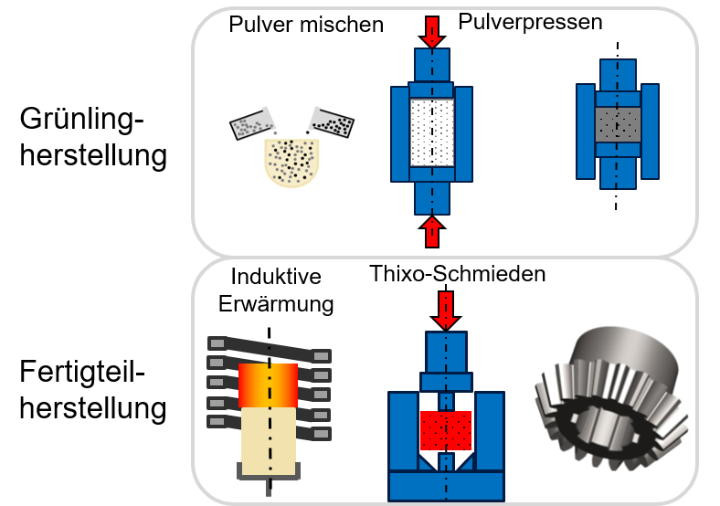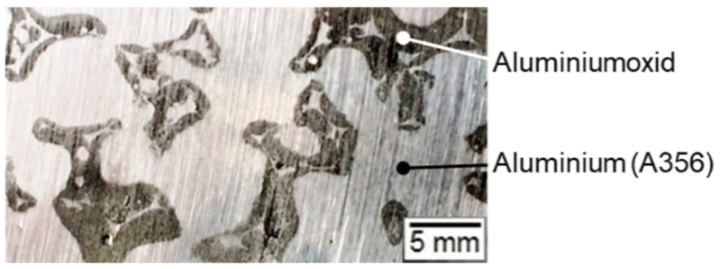The Institute of Metal Forming Technology is engaged in research into the production of hybrid components in near-net-shape quality through moulding in a semi-liquid material state. In addition to fundamental research into the heating of hybrid semi-finished products, the Institute also conducts simulations and experimental investigations into the shaping behaviour of such materials and material combinations. In addition to reinforcement components comprising diverse fibre materials, ceramic foams, and high-strength metal inlays, the production of the raw material to be processed also involves the introduction of SiC or Al₂O₃ particles. The primary objective is the fabrication of composite and hybrid components with form-fit and material-fit connections between the constituent materials.
Duration:07.2023 - 06.2025
The utilisation of composite materials, for instance in the construction of vehicles, facilitates the targeted combination of the properties of the composite partners to be customised to specific requirement profiles. Aluminium matrix composite materials (AMC) are frequently employed for this purpose, exhibiting an exemplary strength-to-density ratio and augmented wear resistance. The objective of this research project is, therefore, to devise a manufacturing process for the production of application-specific particle-reinforced AMC components with specifically adjustable material properties, for example, for brake discs.
The novel manufacturing route in this research project comprises two successive steps. In the first process, the particle-reinforced blanks required for thixo-forging are produced. For this purpose, a powder mixer is used to produce a defined mixture consisting of AlSi7Mg0.6 and SiC powder particles with different volume fractions and particle size distributions. A green compact is then cold-pressed using the double-sided pressing process. The aim of green compact production is homogeneous compaction over the entire height of the green compact and homogeneous particle distribution within a volume. The green compacts were produced in a mould with a floating die to ensure double-sided uniaxial pressing, which leads to an almost homogeneous density distribution in the green compact. The densities achieved in the green compacts were significantly influenced by the particle content in the powder mixture, with green compacts containing 50 vol.% SiC showing a lower density with the same applied pressing force compared to green compacts with 30 vol.% SiC. This is due to the high modulus of elasticity of the SiC particles, which absorb a higher proportion of elastic stresses and thus reduce the force required for the compaction and plastic deformation of the aluminium particles. In the second step of finished part production, the green compacts are inductively heated and then pressed into shape by moulding in a semi-liquid state. Initial heating tests showed that a particle content of more than 40 vol.% SiC prevents the generation of the eddy currents required to heat the green compact and therefore inductive heating of cold-pressed green compacts is not possible. Consequently, the green compacts will be heated in a convection oven in the further course of the project. After heating, moulding in a semi-liquid state is intended to ensure homogeneous particle distribution in the component. A brake disc geometry will probably be selected for this in order to test the influence of the process parameters on the particle distribution in the component. The long-term goal is the production of components with up to 50 vol.% SiC particles.
Duration: 04.2021 - 09.2023
Micrograph of a metal-ceramic interpenetrating composite material
Metal-ceramic interpenetration composites have an extended property profile due to the continuous cross-linking of both material components. However, their production using conventional pressure and infiltration processes results in high residual porosity and detachment phenomena between metal and ceramic. The aim of this DFG-funded research project is to produce such composites by moulding in a semi-liquid state in such a way that these deficits can be overcome. As part of the research work, open-pored ceramic bodies made of aluminium oxide are infiltrated with the semi-liquid aluminium alloy A365. A mould concept is being developed to optimise the use of the process, which is also being validated by numerical simulations. The process is then to be optimised with regard to the degrees of freedom to be influenced in shaping tests. The pore size and temperature of the ceramic body during infiltration, the liquid phase content of the alloy and various process parameters are analysed. The infiltration results achieved are evaluated by a comprehensive structural characterisation of the composites produced. The aforementioned deficits of existing processes for the production of metal-ceramic interpenetration composites are of particular importance here. A final determination of relevant mechanical and thermophysical parameters, such as strength and creep resistance, thermal expansion and thermal diffusivity, will also quantify the results of the research project.
Duration: 04.2017 – 05.2019



